Steam and Black Powder : A Civil War Ironclads game at it’s best!
By Tom Gall
The US Civil War (1861-1865) ushered in a new kind of naval warfare. Ships made of metal, powered by steam, ships pushed into service which were never quite made for the task. It was an amazing time and is a great period to game.
Neil Stokes of the St Paul Irregulars has authored a wonderful set of rules call Steam and Black Powder that do a great job capturing the challenges of battle in this era and make for a very fun time.
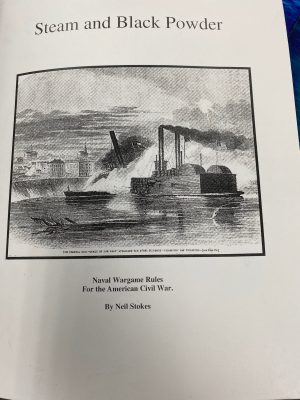
The rule book is 48 pages, with the first 14 pages comprising the rules and the rest made up of tables, ship stats and some historical actions to try out on the tabletop. It’s a fairly quick read and won’t take you much time to get up and running on the tabletop.
A turn is comprised of 5 steps with each side going at the same time, there is no activation system which 0n the one hand eliminates problems like last/firsting but also removes some amount of “drama” hoping you’ll get the drop on someone.
The game uses inches for movement and suggests 1/600 models. In my case I’m using 1/1200 since that is the hardware I have on hand. We didn’t experience any issues and I did not make any adjustments for scale. It just worked.
Game mechanics use D20 and D10, which I’ll go out on a bit of a limb and praise. There are a great number of D6 based games out there using multiple rolls to hit, roll to penetrate, roll to save etc, that could be easily compressed down to a single D20 roll. For what Neil has designed, you’ll see in a moment where his choice makes for superior gameplay.
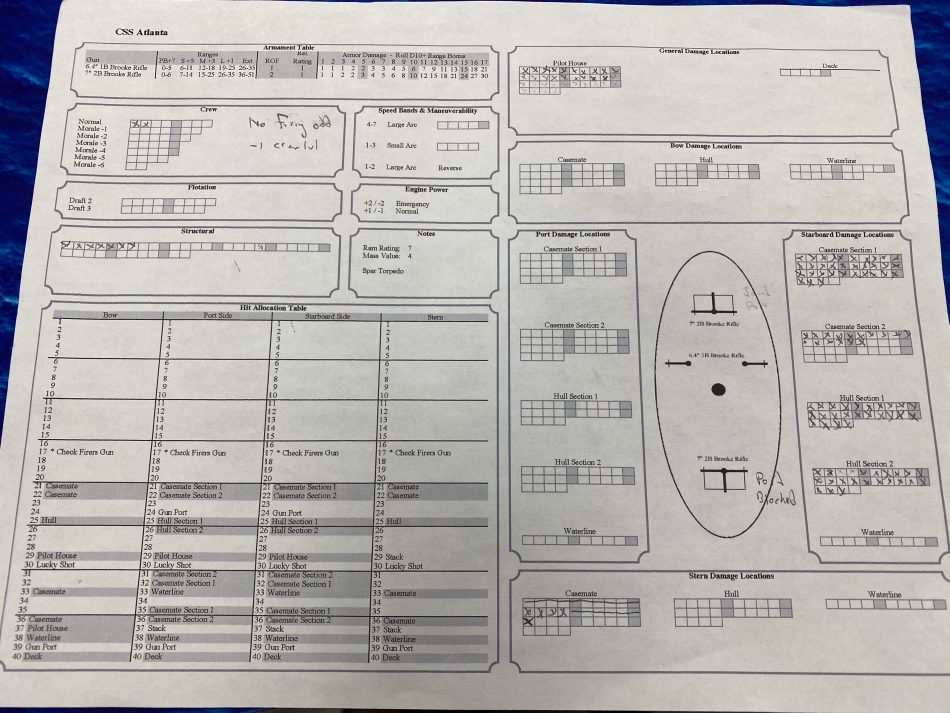
Each ship has a stat sheet. There are rules where you can design your own ships, and the rulebook contains many ship stat sheets. Thankfully on the of many / most / all(?) civil war era ships that historically existed.
Above you’ll see the CSS Atlanta stat sheet captured during a game in progress. In the upper left are the gun stats, under which are crew, speed, floatation, structure, ram/spar torpedos and the lastly the hit allocation table.
In this game, when someone shoots at you, they roll a D20 + modifiers and consult the hit allocation table of the ship being fired at. This is a wonderful mechanic as ships like the USS monitor which sat very low in the water are quite a bit harder to hit than some paddlewheel cotton clad.
On the right side of the sheet are the various locations and their armor (if available!). You’ll notice that the CSS Atlanta has taken considerable hits on the starboard side.
Last the graphic of the ship notes where and what type of guns the ship has. In the case of the Atlanta she had 4 guns where the forward and aft gun could pivot and be used for broadsides.
Movement in the game is in inches, with a steam-powered ship maxing out around 6″ per turn of movement or so. At the top of the turn, each player plots out the movement for their ship. Movement is then excited by all players at the same time. If a couple of ships are looking like they will run into each other, page 8 of the rules has a table where each affected ship is potentially moved during one of 15 phases.
A ship moving at 15″ will move in all phases, while a ship moving at 7″ will only move in 7 of the 15 phases. You move your plotted move during the phase you’re told, if the models hit, they hit and figure out the ram damage, miss and whew! Going for the ram during the era or utilizing a spar torpedo (lots of explosives at the end of a long pole) were tactics of the time.
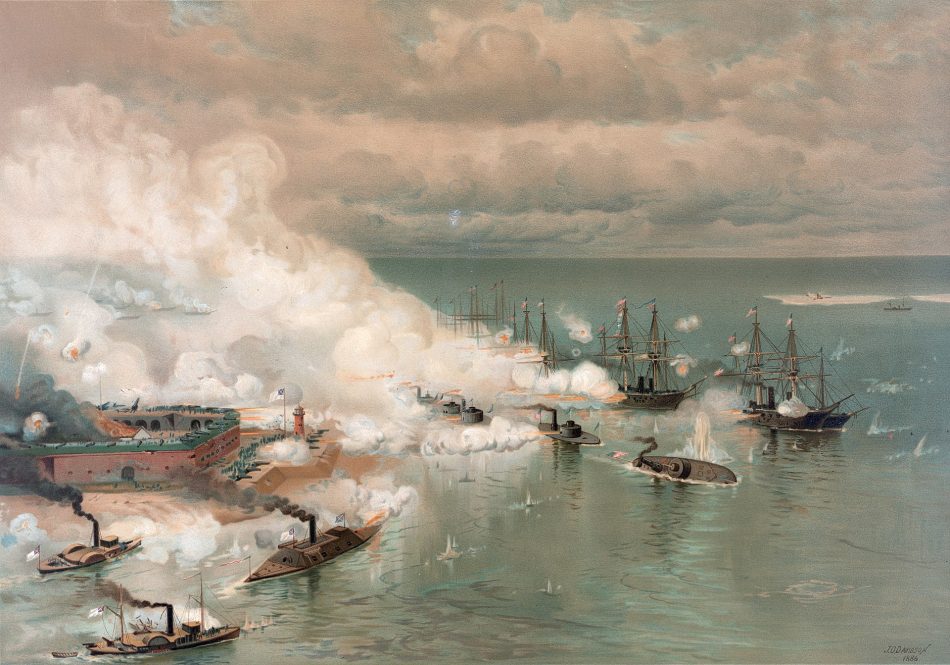
Firing as mentioned is D20 based. There are quite a number of modifiers, tho after a couple of turns, one gets fairly tuned to the addition. +7 – +13 is uncommon for a game and generally, the swing is due to mostly to range, tho a new target coming into arc, for instance, won’t get a +2 modifier. If your crew isn’t in the best morale, you won’t get to benefit from a +1 modifier. Clear conditions is a +1. Daylight is a +1, etc.
As noted before to determine if you hit you consult the hit allocation table for the ship you’re firing at. If the box has text, it’s a hit. If the box has shaded text, it’s a hit against armor, text which ISN’T shaded would generate a critical hit. Next, you roll a D10 adding in just the range modifier and consult the top left part of your stat sheet for your gun stats. The 7″ Brooks Rifle firing at long range (+1), rolling a 4 on a D10, after adding in the modifier to a 5, would result in 3 boxes being marked off depending on where it hit the target.
If the section you hit has had all its armor boxed checked off it’s a critical hit. There is a critical hit table for each section table, roll a D20 on that table and enjoy wonderful effects like boiler explosions, or casements being punctured, fires starting and other disastrous results. After having done so, the target ship must roll a morale check which could result in them striking their colors.
Lucky hits (a 30) are resolved by rolling a d10 and adding 30 to a result. Then you consult the ship hit allocation table for the ship that was the target and then resolving a critical hit.
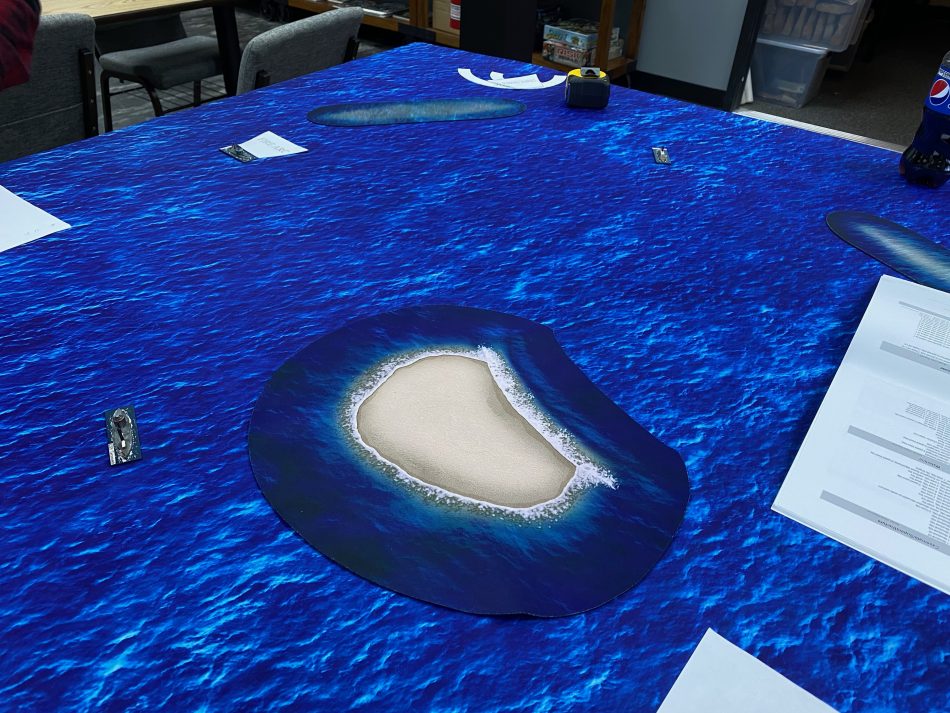
On Saturday at D6 Games in Rochester Mn, we elected to play out a historical scenario involving the CSS Atlanta trying to break the Union blockade on the Savannah River on June 17th, 1863. The USS Nahant and USS Weehawken were both laying in wait and moved to give battle. Here is a in case you’re interested in what really happened.
The CSS Atlanta at the top of the game quickly learned that its rifled guns could outdistance the Passaic class ironclads. The challenge to the confederate captain was how to best engage at range fighting one union ship at a time.
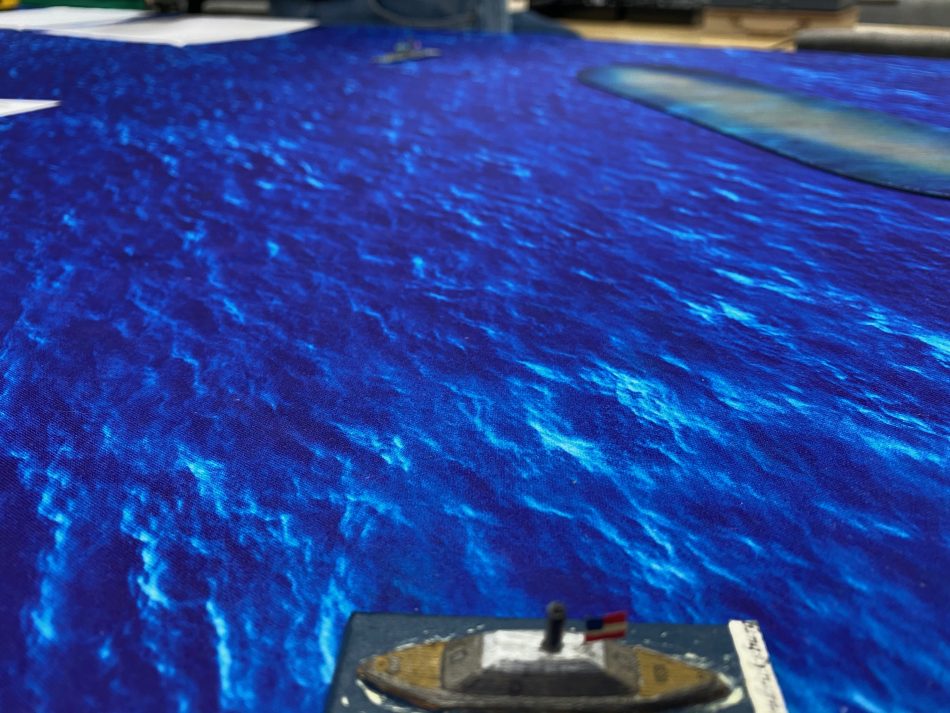
The initial broadside was fairly decent however the union ships are quite hard to hit as only their turrets really stick up above the waterline and their armor is quite effective. Still 80lb “bolts” out of the 7″ Brook rifles carry a punch!
On the union side, each iron clad was armed with an 11″ and 15″ Dahlgren smoothbores. Great guns but with only a maximum of 16″ and 18″ range. They will need to close to get any work done.
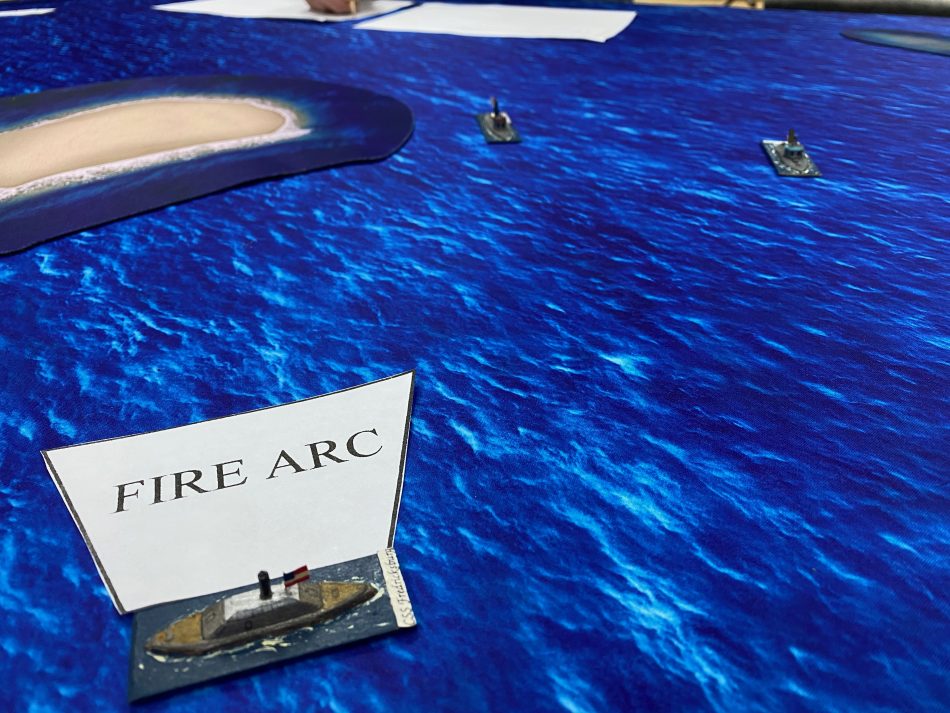
Rolling ahead a few turns, the CSS Atlanta is starting to steam around the island and the Union ironclads are giving chase. This brings up an interesting challenge for the times. The union ships fire on turret and are able to shoot 360 degrees while the CSS Atlanta has but a 20 degree. This was one of a couple of turns where great seamanship by the Union kept them out of arc of the Confederate guns.
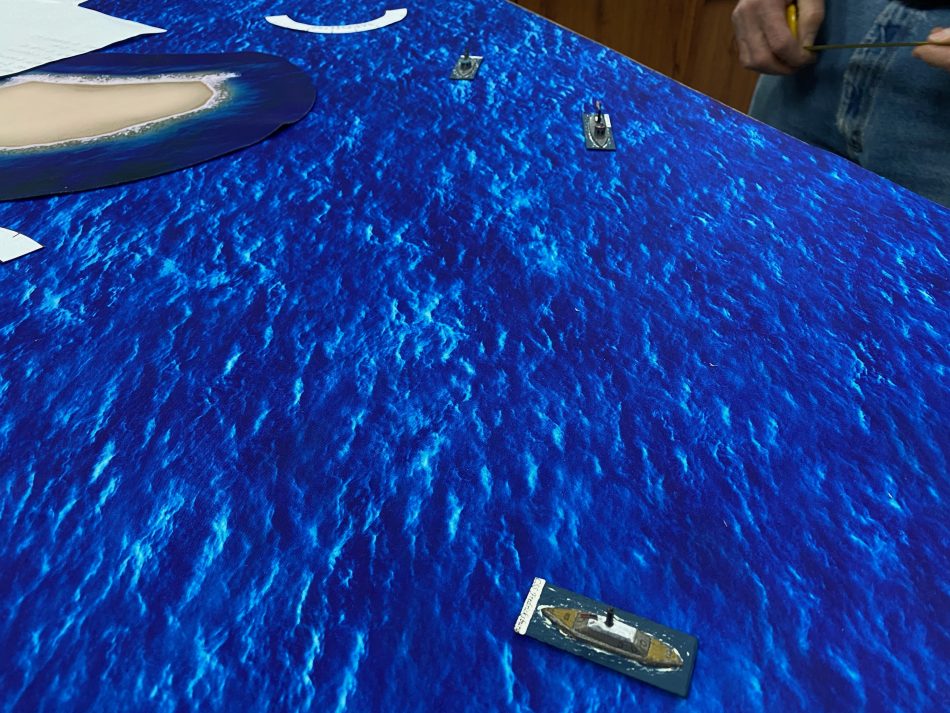
By this point in the battle, things were getting a little desperate on board the CSS Atlanta. Her starboard side had taken a pounding, while both Union boats had taken more than few divots on their turrets but otherwise were not too worse for the wear save for the challenges of fire at long range. The CSS Atlanta elected to swing around bringing to bear the other side and hoped maneuver such that she could engage one boat at a time and hopefully causing one of the Union ships to be unable to fire due to a friend being in the way.
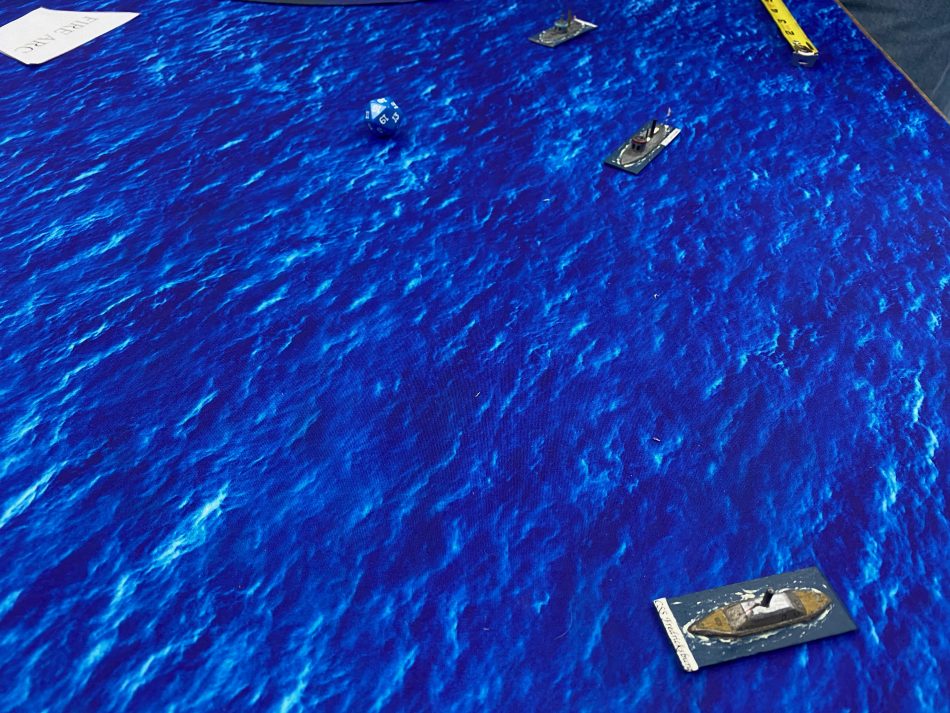
The tactic worked but at the cost of Dahlgrens now being in a very effective range. Unfortunately, this resulted in a series of critical hits over two turns that included, a small and medium fire, the boilers on the CSS Atlanta exploding and the crew finally deciding that the fight was over and striking her colors.
A historical result.
Summary
If you’re looking for a great set of rules for this time period, Steam and Black Powder have my highest recommendation. With free PDF stat sheets online, the reasonable simple but very flavorful movement and combat system, the game is excellent.
Getting the rules is a slight challenge as I’m not aware that it’s generally for sale however I do have the contact information for the author and I am happy to connect you with him so you can get your own copy. My email is tom_gall att mac.com.

Nice report. I’ve played a number of ACW naval games over the years. One of the issues with ACW naval warfare is the variety of guns on a single ship especially Confederate. As a consequence in many rules this results in separate die rolls for each gun. How is this addressed in the rules?
It’s an individual die roll per gun or rolls depending on the RoF.